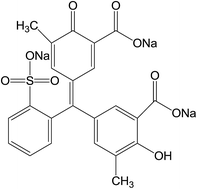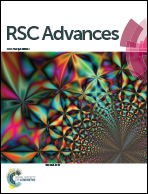Preparation and characterization of MWCNTs functionalized by N-(3-nitrobenzylidene)-N′-trimethoxysilylpropyl-ethane-1,2-diamine for the removal of aluminum(iii) ions via complexation with eriochrome cyanine R: spectrophotometric detection and optimization
Abstract
A novel adsorbent was fabricated by covalently anchoring N-(3-nitro-benzylidene)-N′-trimethoxysilylpropyl-ethane-1,2-diamine onto multiwalled carbon nanotubes (NBATSPED-MWCNTs). This novel material was characterized by different techniques such as XRD, SEM, FT-IR and TGA-DTA. Subsequently, it was used for the ultrasound-assisted removal of aluminum(III) ions via its complexation with eriochrome cyanine R (ECR) indicator. The influences of variables such as initial ECR concentration (X1), initial Al3+ ion concentration (X2), adsorbent dosage (X3) and contact time (X4) on the efficiency of the removal process were investigated by small central composite design (CCD) under response surface methodology and genetic algorithm (GA). The process was empirically modeled to reveal the significant variables and their possible interactions. The optimization conditions were set as: 3 min, 20.238 mg, 20 mg L−1 and 15 mg L−1 for sonication time, adsorbent mass, initial Al3+ ions concentration and initial ECR concentration, respectively. Finally, it was found that the equilibrium and kinetics of the adsorption process follow the Langmuir isotherm and pseudo-second-order kinetic model, respectively. From the Langmuir isotherm, the maximum monolayer capacity (qmax) was found to be 46.74 mg g−1 at optimum conditions.


 Please wait while we load your content...
Please wait while we load your content...